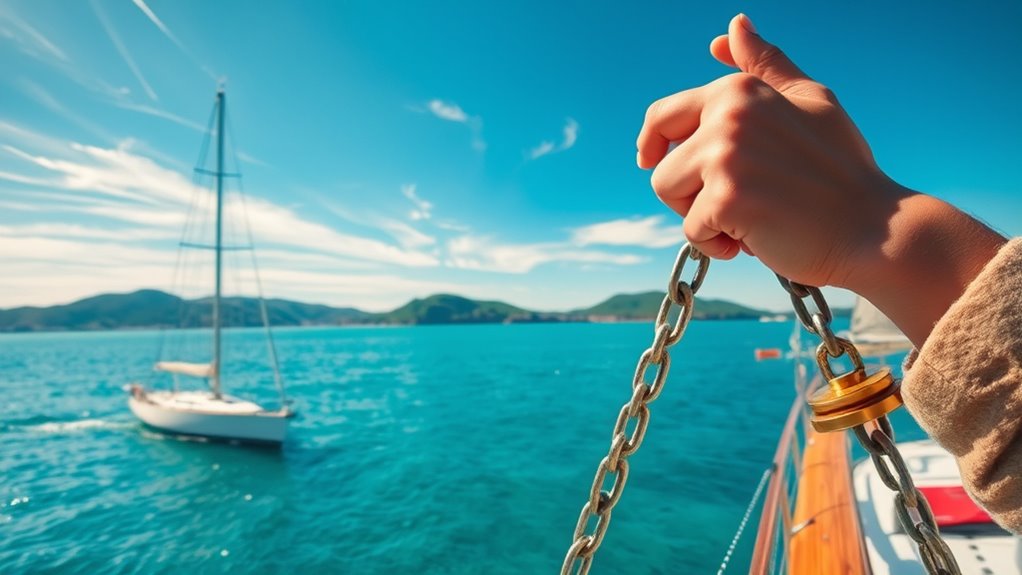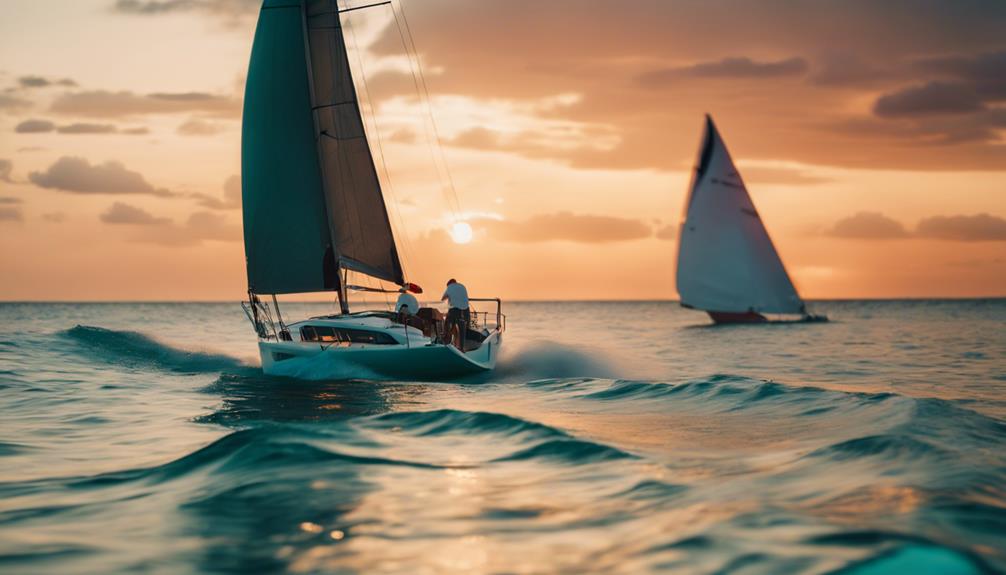To anchor your sailboat effectively, pick a spot with good holding ground and favorable weather conditions. Use the right anchor type and pay out a scope of five to seven times the water depth for stability. Slowly deploy the anchor, ensuring it’s set firmly before paying out more chain. Regularly check your rode tension and inspect equipment for wear. If you keep these tips in mind, you’ll improve your anchoring skills—and there’s more to discover to anchor with confidence.
Key Takeaways
- Choose an anchoring spot with good holding ground, minimal boat traffic, and favorable weather conditions.
- Select the appropriate anchor type and use a scope of 3-5 times the water depth for secure setting.
- Deploy the anchor smoothly, paying out enough rode and gently reversing to set it firmly.
- Regularly monitor the rode tension and scope, adjusting as weather or current changes occur.
- Inspect and maintain your anchor and rode regularly to ensure reliable holding and prevent equipment failure.
Selecting the Ideal Anchorage Spot

Choosing the right anchorage spot is essential for a safe and comfortable sailing experience. You’ll want to consider weather conditions, such as wind direction and strength, to guarantee your boat remains stable and secure. Strong winds or sudden storms can make anchoring risky if you don’t pick a sheltered location. Equally important are navigational hazards like rocks, wrecks, or shallow areas that could damage your hull or make anchoring difficult. Before dropping anchor, scan the area carefully using charts and visual cues. Look for a spot with good holding ground, like mud or sand, and avoid areas with heavy boat traffic or potential hazards. Taking your time to select an ideal anchorage helps prevent problems later and ensures a smooth, enjoyable stopover. Additionally, understanding tiny house legalities in the area can help prevent future legal issues related to anchoring or land use. Being aware of IRA investment strategies can also inform your financial planning for extended stays or land investments near your anchorage location. Properly assessing self watering plant pots can also be useful if you plan to set up a garden at your stopover, ensuring your plants stay healthy during your stay. Moreover, researching the local regulations on anchoring restrictions can save you from fines or conflicts with authorities. It’s also beneficial to check the marine weather forecast to anticipate changing conditions and adjust your plans accordingly.
Understanding and Using Your Anchor and Rode Correctly
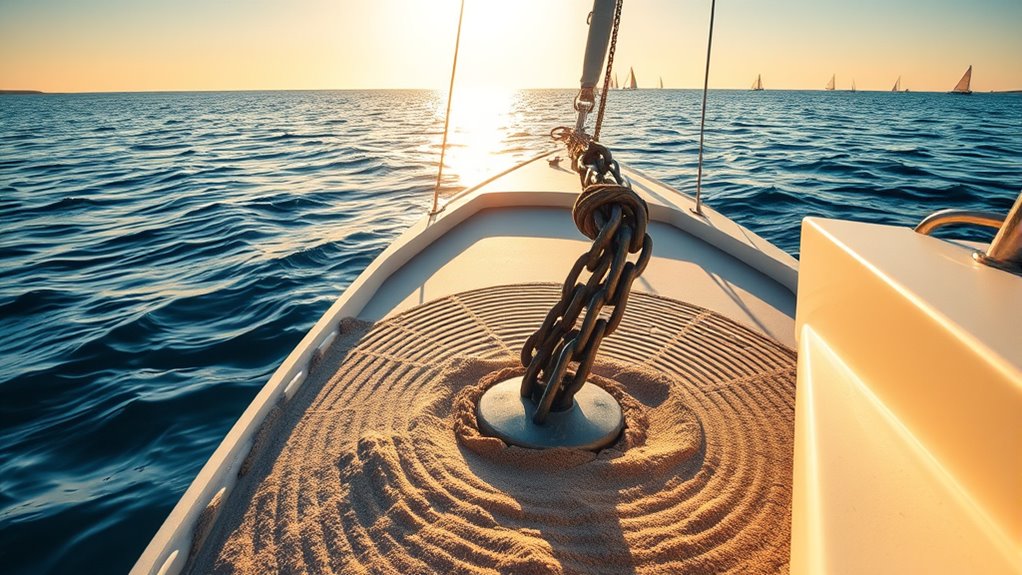
Have you ever wondered if you’re using your anchor and rode effectively? Knowing how to handle different anchor types is essential. For example, plow, fluke, and plow anchors each have unique holding characteristics. Equally important is choosing the right rode materials; nylon is popular for its elasticity, which absorbs shock, while chain provides weight and durability. To ensure your anchoring is secure, always pay attention to rode length—generally, three to five times the depth of water. Proper scope helps maintain tension and stability. When deploying your anchor, keep the rode clear of tangles and ensure it’s laid out smoothly. Regularly inspect your rode for wear or damage, and understand how each component contributes to holding your boat safely.
Approaching and Securing the Anchor Properly
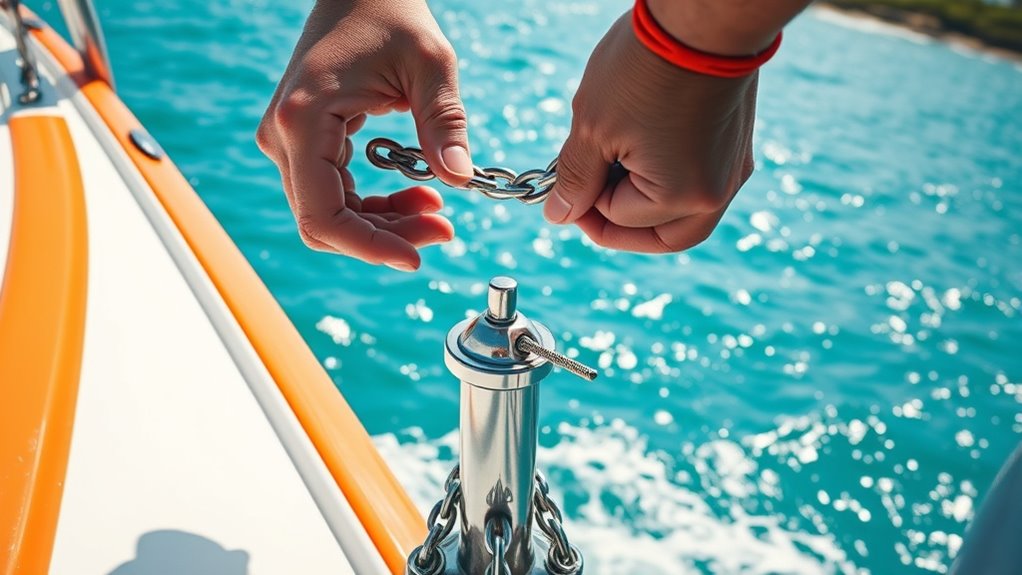
Approaching and securing your anchor correctly is essential to guarantee your boat stays safely in place. As you near your chosen spot, slow down and confirm your boat is steady. When deploying the anchor, pay attention to the anchor chain; let out enough scope—typically 5 to 7 times the water depth—to ensure proper holding power. Keep the chain free of tangles and avoid pulling the anchor up at an angle, which can cause dragging. Once the anchor touches the bottom, gently reverse your boat to set it firmly. Then, gradually pay out more chain to reach your desired scope, ensuring the anchor is well secured. Proper handling of the anchor chain and scope is key to a safe, secure anchoring process. Additionally, understanding the importance of proper anchor selection can significantly improve holding power and stability in various seabed conditions. Choosing the right anchoring equipment based on seabed type can make a substantial difference in securing your vessel effectively. Ensuring your anchor is compatible with different seabed conditions and anchoring gear can optimize safety and efficiency during your anchoring process. Being aware of emotional support strategies can also help you stay calm and focused during challenging anchoring situations, especially in unfamiliar waters.
Monitoring and Maintaining Your Anchor Hold
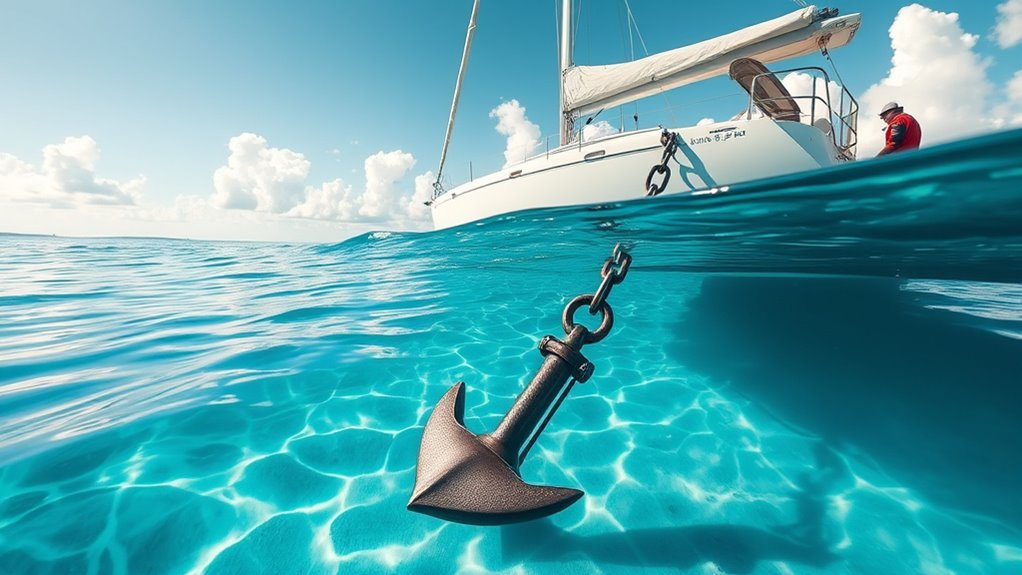
Once your anchor is set, regularly monitor its hold to guarantee your boat stays secure. Check the anchor chain to ensure it hasn’t slackened or shifted, which could signal slipping or dragging. Keep an eye on the anchor rode tension; if it looses considerably, it might mean the anchor is losing its grip. Conversely, excessive tension can stress the anchor and rode system. Adjust the scope if needed to maintain ideal rode tension, especially in changing currents or wind conditions. Periodically inspect the anchor chain and rode for signs of wear, corrosion, or damage. Proper monitoring practices help you catch issues early, preventing potential drag or anchoring failure. Staying vigilant ensures your boat remains safely anchored, giving you peace of mind while relaxing onboard. Additionally, being aware of remote work principles like regular check-ins and routine can help in maintaining a consistent monitoring schedule even when managing multiple responsibilities. Regular maintenance routines are essential to ensure the longevity and reliability of your anchoring system, especially considering the potential effects of corrosion on metal components. Implementing tactical inspections can further enhance your ability to detect early signs of issues before they compromise your anchoring security.
Troubleshooting Common Anchoring Challenges
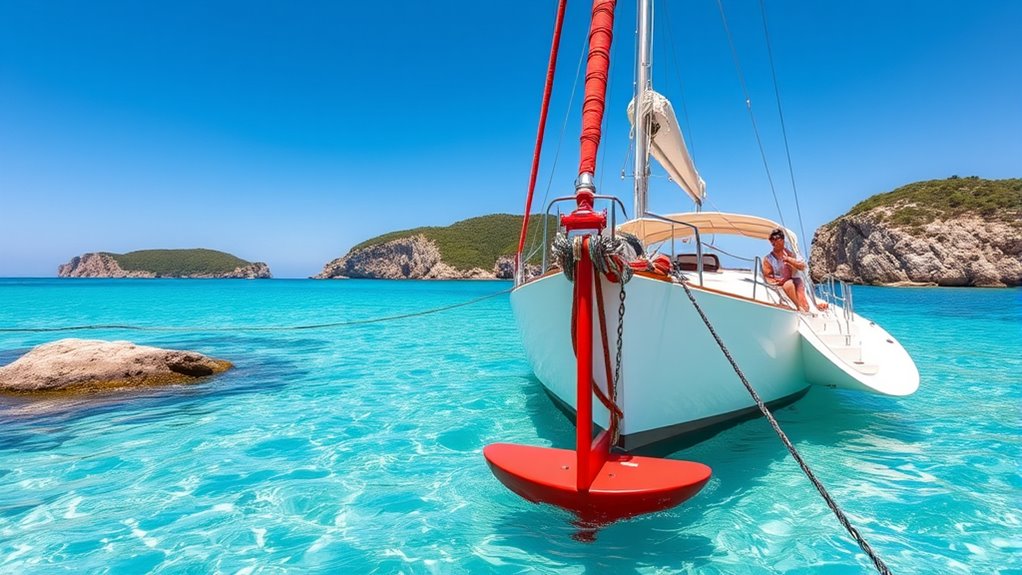
Even the best anchors can face challenges that threaten your boat’s security, but recognizing and addressing these issues quickly can prevent costly failures. If your anchor isn’t holding, check the anchor chain for kinks or tangles that could reduce holding power. Sometimes, the chain’s length needs adjustment; too little scope can cause the anchor to drag, especially in changing wind or current conditions. Proper scope adjustment is vital—aim for at least 5 to 7 times the water depth in calm conditions, more in rougher weather. If your boat drifts unexpectedly, reevaluate your scope and ensure the chain is free and properly laid out. Regularly inspect your chain and anchor for wear, corrosion, or damage to maintain maximum holding strength and avoid surprises when it matters most. Using a high-quality anchor can also significantly improve your anchoring reliability in various conditions, and choosing the right anchoring technology can further enhance your boat’s security. Additionally, employing best anchoring practices can help ensure your anchor performs optimally across different environments. Incorporating proper equipment maintenance, such as cleaning and lubricating your anchor and chain, can also extend their lifespan and effectiveness. Moreover, understanding the environmental conditions where you anchor can help you select the most suitable anchoring techniques and gear for safer mooring.
Frequently Asked Questions
How Do Weather Changes Affect My Anchoring Strategy?
Weather changes can considerably impact your anchoring strategy by affecting weather patterns and tide fluctuations. When weather shifts, you should reassess wind speeds and directions, as stronger gusts may require a more secure anchor. Tide fluctuations can alter your boat’s position, so plan for changing water levels. Always stay updated on weather forecasts, and be ready to adjust your anchor depth and scope to ensure safety and stability.
What Safety Precautions Should I Take During Anchoring?
When anchoring, you should always prioritize safety. Start by inspecting your anchor chain for wear or damage, ensuring it’s secure. Choose the right anchor rode, whether chain or rope, based on conditions. Always set your anchor properly, maintain a watch for shifting weather, and avoid anchoring in restricted areas. Regularly check your gear and keep communication devices handy. Your cautious approach keeps everyone safe and your boat secure.
How Can I Prevent My Anchor From Dragging?
Think of your anchor as a loyal guardian holding your boat steady in a storm. To prevent dragging, you need the right anchor rode selection and proper anchor chain length. Use enough chain so it can absorb waves and hold firm. Keep the rode taut, and always verify that your anchor is set deeply. These steps ensure your boat stays put, even when the seas test your patience.
What Are Signs of a Secure Anchor Hold?
You’ll know your anchor hold is secure when the boat stays steadily in place without drifting, even in changing conditions. Check the anchor chain length to guarantee it’s adequate—ideally, at least 5-7 times the water depth—and select the right anchor rode for your boat size and bottom type. If your boat remains steady with little movement and the chain stays taut, you’ve got a solid anchor hold.
How Often Should I Inspect and Replace My Anchor Gear?
You should inspect your anchor gear regularly, ideally before each trip and at least once a month during active sailing seasons. Regular anchor maintenance involves checking for corrosion, wear, or damage to the shackle, chain, and anchor itself. Replace any gear showing signs of rust, cracks, or deformation immediately. Staying diligent with gear inspection guarantees your anchor remains dependable, keeping your boat secure and preventing mishaps on the water.
Conclusion
Anchoring might seem tricky at first, but with these tips, you’ll gain confidence in handling your sailboat securely. Don’t worry if it takes a few tries to get comfortable—practice makes perfect. Remember, even seasoned sailors face challenges; it’s all part of the learning process. Keep patient, stay attentive, and enjoy the peaceful moments anchor life offers. Before long, you’ll be anchoring like a pro and exploring the water with ease and confidence.

